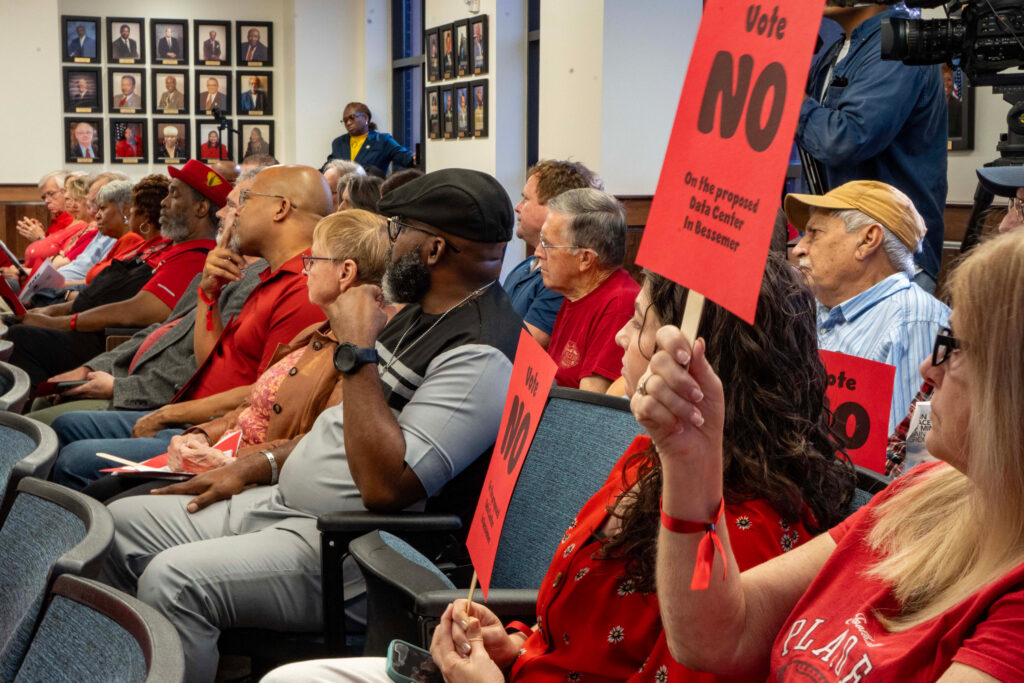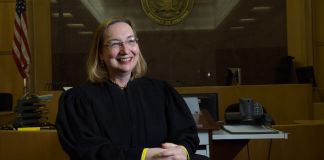BESSEMER, Ala.—The reverend knew what was coming.
As Tuesday’s City Council meeting began, The Rev. Thomas Thrash delivered a prayer that set the stage for the dynamic that would play out in the council chambers.
“May truth rise above deception,” Thrash said. “May righteousness rise above greed.”
Thrash requested divine guidance to help the council consider the harm a proposed hyperscale data center could bring to Bessemer and the surrounding, rural communities in central Alabama.
After the prayer, the council got down to business. Despite vocal opposition from residents, local and state environmental groups and the NAACP, the entire council—save one absent member—voted to amend the city’s zoning code to allow the location of data centers in areas designated for light industrial use.
The decision is the first major step, following repeated delays, toward the approval of Project Marvel, a $14.4 billion hyperscale data center development set to encompass 700 acres and include 18 buildings totaling 4.5 million square feet.
The project has faced consistent, staunch opposition from residents living both within Bessemer city limits and in the rural, unincorporated areas surrounding the proposed development site. Locals have expressed concerns about excessive energy usage, increased utility rates, potential watershed contamination, habitat destruction, noise pollution and years of disruptive construction traffic.
Bessemer’s relatively small City Council chambers were packed to capacity Tuesday evening, with residents spilling into the hallway and herded into an overflow room on a different floor. The only levity in the somber crowd was a spontaneous “Roll Tide” someone interjected after the Pledge of Allegiance.
Residents in the audience were more subdued than in the numerous meetings most had attended again and again as the City Council and Bessemer’s Planning and Zoning Commission considered and reconsidered proposals involving zoning and development plans related to Project Marvel.
Before the council’s vote, President Donna Thigpen emphasized that the ordinance under consideration—a measure to allow data centers in areas with industrial zoning—wasn’t specific to Project Marvel.
“It has been suggested that there’s other properties that might be more suitable or more favorable, but to do that, even in another place, this would have to be had,” Thigpen told those gathered.
Indeed, the proposed ordinance wouldn’t simply impact the possible siting of Project Marvel on land slated to be rezoned from agricultural to light industrial use. Under the proposal, future data center projects, too, could be located in areas zoned for the latter purpose.
Before Tuesday’s vote to change Bessemer’s zoning ordinance, light industrial uses included facilities like bus terminals, gas stations with garages and large billboards. Expressly forbidden from light industrial classification are facilities “which are especially detrimental to property or to the health and safety beyond the district by reason of the emission of odor, dust, gas, fumes, smoke, noise, vibration or waste material.”
Residents have argued that commissioners should vote down the allowance of data centers in light industrial zones because the facilities simply don’t fit the definition of light industrial development and aren’t comparable to facilities that are typically permitted under that classification.
“This is not light industrial,” Becky Morgan, a resident affected by the project, previously told city officials. The facility’s high power consumption, security needs and sheer footprint should require its zoning in heavy industrial or another, newly created zoning category, she argued.

Several other residents spoke during Tuesday’s meeting to express their concerns, asking the council to more deeply research the different types of data centers, their sizes and impacts. But to their consternation, members of the overflow crowd in the downstairs waiting room at City Hall weren’t allowed to voice their views during this meeting.
Sarah Stokes, an attorney at the Southern Environmental Law Center, expressed her dismay that residents among the overflow crowd weren’t allowed to speak and were given no explanation from officials as to why.
“That’s not the law for the public hearing. You have to be able to be heard,” she said.
William Spencer, who owns Spencer Wood Recycling in Bessemer, was also upset by what he viewed as an effort to limit dissent. Spencer said he witnessed a police officer stop a lady in a red shirt “with force” and told her she couldn’t go upstairs to the council meeting to speak.
Ultimately, the council voted unanimously to approve the change to the city’s zoning ordinance, making way for data centers of any size and scope to be located in land zoned for light industrial use.
Spencer called the council’s rapid approval a farce.
“I think that they’re railroading,” he said. “For them to make it light industrial and give a positive spin on light industrial for something that’s heavy industrial pulling all of this diesel power, I think that it’s a farce.”
Spencer wasn’t the only one to think the fix was in before the meeting even began.
In a press release issued the day before the council’s formal vote, the Bessemer City Council reaffirmed its full support for the data center as a “tremendous investment” with economic benefits for both the city and state of Alabama.
At least one city council member has also been vocal about his support for the project, painting those opposing it as outsiders aiming to halt a project at the expense of Bessemer’s city government.
This story is funded by readers like you.
Our nonprofit newsroom provides award-winning climate coverage free of charge and advertising. We rely on donations from readers like you to keep going. Please donate now to support our work.
In response to a postcard by the Alabama Rivers Alliance, an environmental nonprofit, sent to Bessemer residents urging them to tell their council members to vote against the data center, City Council member Chester Porter wrote on social media that concerned citizens living outside the city limits had no place to tell Bessemer citizens what to do.
“Telling Bessemer citizens what to do with our land is like showing up at their community meeting and telling them to plant apple trees in their front yards and build swimming pools by their mailboxes,” he said.
The land involved in the proposed project hasn’t always been located within Bessemer, but was annexed into city limits in recent years. The site is located on the extreme edge of the city, about six miles from the city center.
And not everyone views concerned citizens living outside the city limits as undue, outside interference.
“Quite frankly, if we want to talk about outsiders, there’s only one person in that room upstairs that I know of that doesn’t live in Jefferson County, and that’s the developer,” said Charles Miller, policy director for Alabama Rivers Alliance.
Shelby Standfield, an architectural designer who suffers from chronic asthma, moved from Birmingham to McCalla, an incorporated area of Jefferson County adjacent to the proposed data center site, to escape poor air quality. Even though she’s not within the city limits, she goes to Bessemer to shop for all her amenities.
“Air pollution knows no boundaries. It doesn’t know where the county line is,” she said. Even though she lives ten miles away from Bessemer’s city limits, Standfield’s home is located just up the road from the site where, if approved, dozens of diesel generators could soon be located as a backup power source for the data center. “I live closer than some people who actually live in Bessemer,” she said.
Edith Hunter, a breast cancer survivor and Bessemer resident, also pushed back on the notion that those outside the city limits won’t be affected by air pollution.
“Smoke is not just going to settle in Bessemer,” she said.
She said she believes the proposed development is a “done deal” and a “money grab.”
The Bessemer City Council is expected to formally consider the data center’s development plan, one of the final steps in the approval process, at a meeting on Nov. 18.
Lee Hedgepeth contributed reporting for this story.
About This Story
Perhaps you noticed: This story, like all the news we publish, is free to read. That’s because Inside Climate News is a 501c3 nonprofit organization. We do not charge a subscription fee, lock our news behind a paywall, or clutter our website with ads. We make our news on climate and the environment freely available to you and anyone who wants it.
That’s not all. We also share our news for free with scores of other media organizations around the country. Many of them can’t afford to do environmental journalism of their own. We’ve built bureaus from coast to coast to report local stories, collaborate with local newsrooms and co-publish articles so that this vital work is shared as widely as possible.
Two of us launched ICN in 2007. Six years later we earned a Pulitzer Prize for National Reporting, and now we run the oldest and largest dedicated climate newsroom in the nation. We tell the story in all its complexity. We hold polluters accountable. We expose environmental injustice. We debunk misinformation. We scrutinize solutions and inspire action.
Donations from readers like you fund every aspect of what we do. If you don’t already, will you support our ongoing work, our reporting on the biggest crisis facing our planet, and help us reach even more readers in more places?
Please take a moment to make a tax-deductible donation. Every one of them makes a difference.
Thank you,
Great Job By Lanier Isom & the Team @ Inside Climate News Source link for sharing this story.






